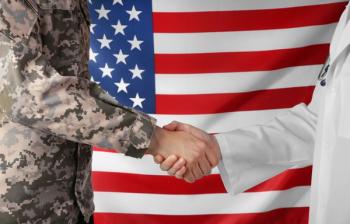
COVID-19 Loneliness
The pandemic has kept people apart. What are the mental health consequences of being alone? And what would be the benefits of getting back together?
CLINICAL REFLECTIONS
As the world slowly sheds the weight of COVID-19, there is an opportunity for psychiatrists to pause and consider the role they are about to play in the coming months and years. Never before has the entire modern world been subjected to such collective feelings of fear, uncertainty, anxiety, and sorrow—and loneliness.
Individuals around the world did their part to slow the spread of
About 36% of Americans reported feeling “serious loneliness” in the wake of the pandemic, according to
The effects of pandemic-related isolation have been felt in every corner of society. It may take the form of exacerbated symptoms in some patients or freshly developing signs of mental illness in others. Medically, loneliness has been linked to
Psychiatry often relies on pharmaceuticals to treat mental illness; this
Studying Loneliness
More than any other species, humans are dependent on others for longer periods of time. In fact, the average individual spends about 80% of their waking hours in the company of others.4
Loneliness is not necessarily the result of being alone. One can easily feel lonely even when surrounded by others. Because loneliness is more often a perception, feelings of isolation can trigger hypervigilance, in which the world appears to be a threatening place.6 Individuals who are lonely tend to be more critical of themselves.7 When these negative expectations are confirmed by the behavior of others, this creates a
Loneliness apparently loves company, with studies describing it as
“In loneliness, the lonely one eats himself; in a crowd, the many eat him,” Friedrich Nietzsche once said.11 Culturally, loneliness can be seen as a sign of weakness or self-pity. For instance, 1965 study of rhesus monkeys Found that when a group of socially isolated monkeys were reintroduced to their colony, they were driven off or eliminated.12
In 2018, the United Kingdom’s BBC Radio 4 released results from
The study found young individuals experienced the most loneliness, with 40% of 16- to 24-year-olds feeling lonely often or very often, in comparison with 29% of individuals aged 65 to 75. Young men in particular were more susceptible to feelings of loneliness, and their loneliness was more intense and longer-lasting.
Most of the research on loneliness was conducted before COVID-19 sent us into lockdown, so it is too soon to consider the pandemic’s long-term effects. However, recent studies have tracked the impact of social distancing and quarantine, and they have left an intriguing bread-crumb trail of predictions.
Pandemic Worries
When COVID-19 struck, many experts worried suicide rates would skyrocket.14 A 2020 report from the Centers for Disease Control and Prevention showed a 35% increase in suicide mortality in the US from 1999 to 2018, a trend most people expected to continue.15
The review also found health care workers in particular suffered from the loneliness and isolation of quarantine. Theyendured increased severe symptoms of
Like every facet of society, health and mental health organizations have had to rethink how to serve their patients, especially when they could not be treated in person. Mental health care providers were encouraged to find alternate ways to deliver services, provide clear pathways for those considering suicide, and quickly offer bereavement services when needed. We can assess for loneliness by using the revised University of California, Los Angeles (UCLA) loneliness scale.17 One way to approach the conversation is to ask patients what they are doing during their free time and if they have any friends or family they spend time with. Since the COVID-19 pandemic, it is likely a lot more patients have indicated they are lonely.
Nurturing the Doctor-Patient Alliance
Individuals need quality information and strategies to cope with loneliness, in addition to help identifying and managing self-defeating thoughts. Comprehensive assessments like the revised UCLA Loneliness Scale and access to round-the-clock counseling networks could throw vital lifelines to patients suffering from loneliness.19
Innovative Programs
In France, the VigilanS suicide prevention system was implemented before COVID-19 began. It rapidly adapted by following up with at-risk patients on the 10th day rather than the 20th. Early data regarding this intervention shows a sharp decrease in
More than anything, individuals need to be comforted that they are not alone and shown a way to overcome their loneliness. Often, the solution is to address loneliness with kindness.
Pulling Together
Ironically, suicide rates generally dip after major events that are shared by large populations.25 During COVID-19, CDC statistics found provisional
It is this line of reasoning that developed the
To be sure, the stress of COVID-19 has affected mental health around the world.
As psychiatrists, we tend to be biased in thinking that everything can be fixed with medication; however, the danger is that we forget to see the human person in front of us. While medication can help, often their problem is much more complex and needs more than medication treatment. We should not overlook patients we think are lonely and instead provide tips, such as being active on social media and staying in touch with friends through Zoom and Facebook. Although in-person relationships are always better than virtual ones, virtual ones are better than nothing. The worst thing to do when lonely is to completely isolate and not talk to anyone through social media.
As psychiatrists, we are on the front lines and can affect whether some people live or die. Let us rise to the occasion and treat everyone with kindness and compassion and in doing so, save thousands of lives.
Dr Lagoy is staff psychiatrist at Community Psychiatry in San Jose, CA.
References
1. Harvard University. Loneliness in America: How the pandemic has deepened an epidemic of loneliness and what we can do about it. February 2021. Accessed May 13, 2021.
2. Harvard Health Publishing. Loneliness has same risk as smoking for heart disease. June 16, 2016.
3. Weeks DG, Michela JL, Peplau LA, Bragg ME. (1980). Relation between loneliness and depression: A structural equation analysis. Journal of Personality and Social Psychology. 1980;39(6):1238-1244.
4. Kahneman D, Krueger AB, Schkade DA, et al. A survey method for characterizing daily life experience: the day reconstruction method. Science. 2004;306(5702):1776-1780.
5. Lonely. Merriam-Webster. Accessed May 13, 2021.
6. Hawkley LC, Cacioppo JT. Loneliness matters: a theoretical and empirical review of consequences and mechanisms. Ann Behav Med. 2010;40(2):218-227.
7. Besser A, Flett GL, Davis RA. Self-criticism, dependency, silencing the self, and loneliness: A test of a mediational model. Personality and Individual Differences. 2003;35(8):1735-1752.
8. Breann A. What is the loneliness loop and how can I break free from it? Younique Foundation. Accessed May 13, 2021.
9. Remes O. Loneliness is contagious – and here’s how to beat it. Cambridge University. July 16, 2018.
10. Cacioppo JT, Fowler JH, Christakis NA. Alone in the crowd: the structure and spread of loneliness in a large social network. J Pers Soc Psychol. 2009;97(6):977-991.
11. Nietzsche F. A Nietzche Reader Selected and translated. Penguin Books; 1984.
12. Harlow HF, Dodsworth RO, Harlow MK. Total social isolation in monkeys. Proc Natl Acad Sci USA.1965;54(1):90-97.
13. BBC, University of Manchester. The BBC Loneliness Experiment. Accessed April 30, 2021.
14. Courtet P, Olié E, Debien C, et al. Keep socially (but not physically) connected and carry on: preventing suicide in the age of COVID-19. J Clin Psychiatry. 2020;81(3):20com13370.
15. Hedegaard H, Curtin SC, Warner M. Increase in suicide mortality in the United States, 1999–2018. NCHS Data Brief, no 362. National Center for Health Statistics; 2020.
16. Brooks SK, Webster RK, Smith LE, et al. The psychological impact of quarantine and how to reduce it: rapid review of the evidence. Lancet. 2020;395(10227):912-920.
17. Hughes ME, Waite LJ, Hawkley LC, Cacioppo JT. A short scale for measuring loneliness in large surveys: Results from two population-based studies. Res Aging. 2004;26(6):655-672.
18. Flückiger C, Del Re AC, Wampold BE, Horvath AO. The alliance in adult psychotherapy: A meta-analytic synthesis. Psychotherapy. 2018;55(4):316-340.
19. Russell D, Peplau LA, Cutrona CE. The revised UCLA Loneliness Scale: concurrent and discriminant validity evidence. J Pers Soc Psychol. 1980;39(3):472-80.
20. Fossi Djembi L, Vaiva G, Debien C, et al. Changes in the number of suicide re-attempts in a French region since the inception of VigilanS, a regionwide program combining brief contact interventions (BCI). BMC Psychiatry.2020;20(1):26.
21. Pittman M, Reich B. Social media and loneliness: Why an Instagram picture may be worth more than a thousand Twitter words. Computers in Human Behavior. 2016;62:155-167.
22. Cauberghe V, Van Wesenbeeck I, De Jans S, et al. How adolescents use social media to cope with feelings of loneliness and anxiety during COVID-19 lockdown. Cyberpsychology, Behavior, and Social Networking. 2021;24(4):250-257.
23. Nelson SK, Layous K, Cole SW, Lyubomirsky S. Do unto others or treat yourself? The effects of prosocial and self-focused behavior on psychological flourishing. Emotion. 2016;16(6):850-61.
24. Weissbourd R, Batanova M, Lovison V, Torres E. Loneliness in America: How the pandemic has deepened an epidemic of loneliness and what we can do about it. Harvard Graduate School of Education. February 2021.
25. Nishio A, Akazawa K, Shibuya S, et al. Influence on the suicide rate two years after a devastating disaster: A report from the 1995 Great Hanshin-Awaji earthquake. Psychiatry Clin Neurosci. 2009;63(2):247-250.
26. Ahmad FB, Anderson RN. The leading causes of death in the US for 2020. JAMA. March 31, 2021.
27 Ahmad FB, Cisewski JA, Miniño A, Anderson RN. Provisional Mortality Data - United States, 2020. MMWR Morb Mortal Wkly Rep. 2021;70(14):519-522.
28. Claassen CA, Carmody T, Stewart SM, et al. Effect of 11 September 2001 terrorist attacks in the USA on suicide in areas surrounding the crash sites. Br J Psychiatry. 2010;196(5):359-364.
29. Joiner TE, Hollar D, Van Orden K. On Buckeyes, Gators, Super Bowl Sunday, and the miracle on ice: “Pulling together” is associated with lower suicide rates. J Soc Clin Psychol. 2006;25(2).
30. Klonsky ED, May AM. The Three-Step Theory (3ST): A new theory of suicide rooted in the “ideation-to-action” framework. J Soc Clin Psychol. 2015;8(2).
31. Czeisler ME, Lane RI, Petrosky E, et al. Mental health, substance use, and suicidal ideation during the COVID-19 pandemic — United States, June 24–30, 2020. Centers for Disease Control and Prevention. 2020;69(32):1049-1057.
Newsletter
Receive trusted psychiatric news, expert analysis, and clinical insights — subscribe today to support your practice and your patients.














